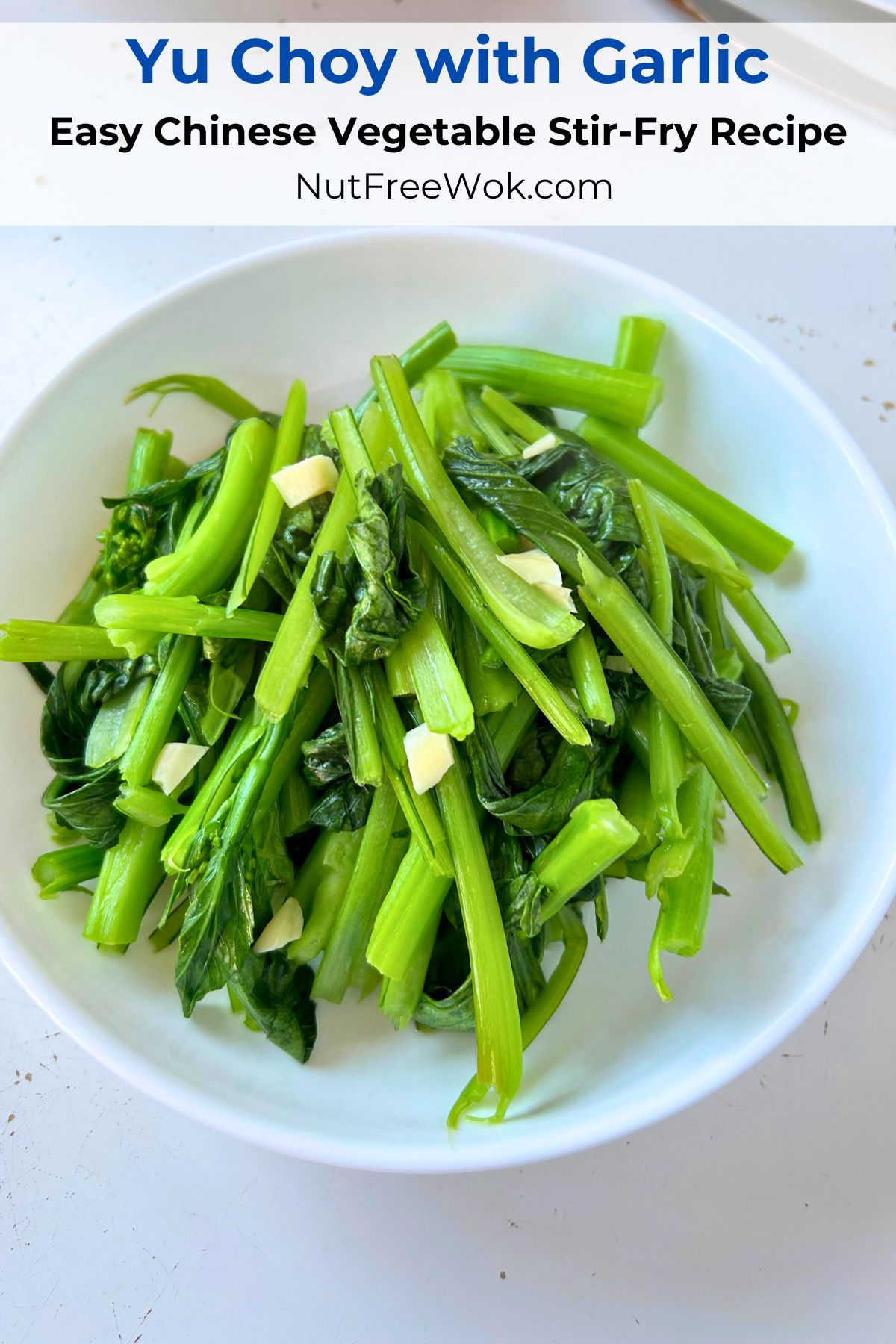
Learn how to make Yu Choy, an easy Chinese vegetable stir-fry with garlic. Yu choy is one of the tastiest Asian vegetables. This side dish recipe is free of top 9 food allergens. Also learn how to recognize this delicious Chinese vegetable when you see it and learn how to prep and cook it authentically.
Disclaimer: Please check that all ingredients are suitable for your allergies and be sure to ask your medical care team regarding any allergy related questions (I do not share medical advice). As an Amazon Associate, I earn from qualifying purchases.
What Is Yu Choy? Is It the Same as Choy Sum?
Yes! Yu choy is also called choy sum (literally “vegetable heart” in Chinese) or yu choy sum in Cantonese. Choy sum can also refer to tender baby greens, for example baby bok choy would be called “bok choy sum.” However, “choy sum” would refer to yu choy every time. Yu choy is related to bok choy and gailan, Chinese vegetables in the mustard family. It is mild tasting like bok choy and not as bitter or spicy like gailan.
Chinese restaurants almost always have items available that aren’t on the menu. Yu choy is one of them and you may need to ask. If it’s available a local Chinese restaurant, that means there is a grower in your area. Yu choy is available year-round where I live. Be on the lookout for them especially during cooler weather months in spring and fall.
How to Identify Yu Choy by Sight
You will find them in bunches or bundled in a plastic bag at an Asian supermarket or a farmers market. The vegetables might not always be labeled consistently so you need to be able to recognize them by sight.
The most common varieties of yu choy have an overall green appearance. I bought some purple yu choy once and they turn green when cooked and tasted the same.
Yu choy leaves are flat and a slightly darker shade than the stem and stalk portions. The vegetables are between 6-12 inches in length and the stalks are between 1/4 inch to 1/2 inch in diameter. It’s easy to recognize yu choy’s small bright yellow flowers, which may be present depending on the growing stage.
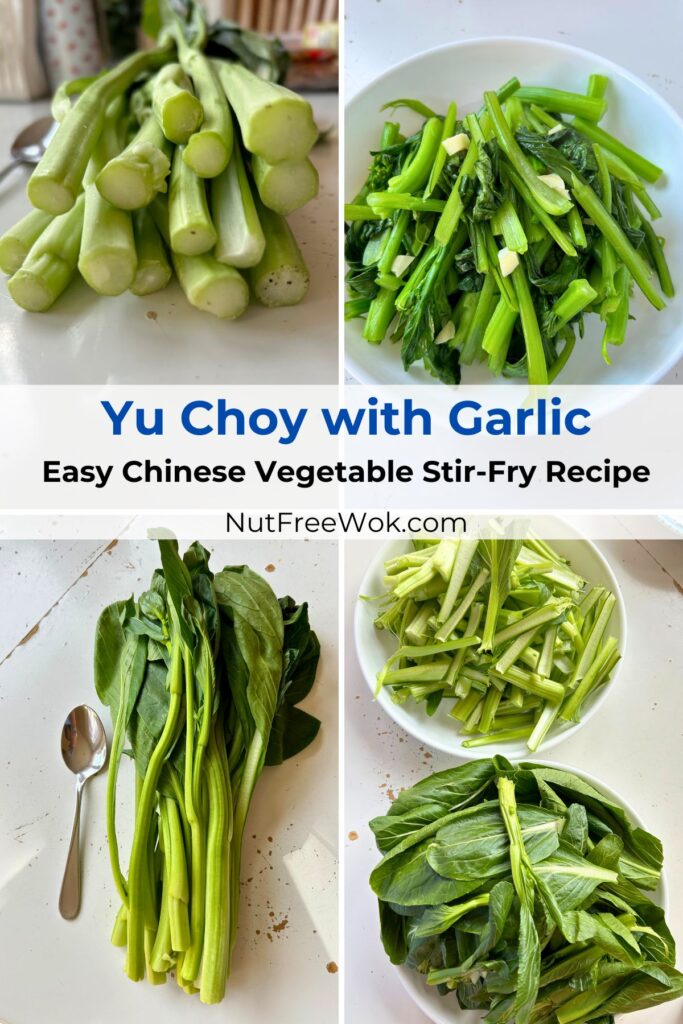
How to Select Yu Choy
What you want is the most tender yu choy. Tender yu choy is incredibly delicious even boiled and served plain. It’s crunchy and tender, has a mild taste for a vegetable in the mustard family. Stir-frying it with oil, minced garlic, and a touch of salt is fabulous.
Of course you will want to select fresh looking greens that aren’t yellowed or wilted, and heavy for its size. Leaves which are turning yellow or brown are discarded, the yu choy has been sitting around too long. If the leaves are slightly wilted but green, they will perk up when you wash and soak them.
The more tender varieties of yu choy are 6-9 inches with a medium sized stalk. The bigger, longer varieties of yu choy are also fine if they’re harvested young.
If yu choy have bright yellow flowers, then check that the cut bottoms are light green. When you see white spots, then that’s a sign that the yu choy might be a little bit chewy. I usually pass and make other Chinese leafy green vegetables. Can’t go wrong with Baby Bok Choy Instant Pot Recipe, Tender Crisp, Chinese-Style. I also love Napa Cabbage Stir Fry. And always buy some pea shoots when they’re on sale to make Pea Shoots with Garlic and Ginger Recipe.
I usually plan to eat yu choy on the day of purchase or the next day. If you wait a few days or forget about them, the leaves start to turn yellow which need to be discarded and it takes longer to sort and prep, and you end up with more waste and less to eat.
How to Wash Chinese Vegetables
What do you use to contain your vegetables when you wash your vegetables? I use a large colander bowl set that nests together. It’s easy to take all the veggies out with my colander, pour out the water, and check if any dirt remains in the bowl. Then drain the vegetables drain until ready to cook. I also have a salad spinner that I can use but it has a slightly smaller capacity.
- I fill a large vegetable bowl with water and swish the greens around to loosen the dirt off and then change the water.
- If the vegetables seem wilted, I will cut a thin slice off the stalk (1/8 inch) and then soak the veggies in fresh clean water for 15 minutes as needed.
- Change the water again and during the third wash, I pull the large leaves off the stalk and leave the small tender leaves (stem is 3 inches or shorter) attached to the stalk.
- Swish the vegetables in the water and take them out and check that the rinse water is grit-free.
The washing process uses a lot of water. I keep a 2-3 gallon bucket in my kitchen to save the water used to wash rice, vegetables, and fruit and use the gray water for my plants. This greatly helps to conserve water, prevents dirt from clogging my plumbing, and helps me to get outside more.
Prepping Yu Choy
When the vegetables are sufficiently clean, you will want to trim the vegetables into bite sized pieces and sort them into two prep bowls, one for leaves and tender tips and a second one for stems and stalks. The reason you want to separate them into two bowls is that it takes a little bit longer to cook the stems and stalks. The stems and leaves go into the frying pan first and when they’re partially cooked, add the leaves.
Remove the large leaves from the stalk. Trim the stem part of the leaf into one or two 3-inch sections and put the leaf section into the leaf bowl and the stem sections into the stem and stalks bowl.
From the bottom of the stalk, cut the stalk into 2-3 inch sections depending on the thickness but leave the top 3 inches of the tender tip intact and add them to the leaf bowl.
Can you cook and serve yu choy whole, without trimming? Yes, but only when they’re the short, tender variety. A few years ago I was able to buy yu choy from a farmer that grows Chinese vegetables for restaurants, which are better quality. I could see why restaurants could cook and serve the whole stalk, without trimming. Whole yu choy is awkward to eat with chopsticks (and without a knife), I recommend trimming into bite sized pieces.
Yu Choy Recipe Variations
My recipe for yu choy is the easy and tasty. There are easier methods and tastier ways, but this is what works for my personal preferences for efficiency, nutrition, and taste.
The easiest way is to simply cook it in boiling water until it turns bright green and is tender-crisp. I would definitely cook them this way when pressed for time and/or when the rest of the meal is heavy or rich.
If serving it as a tasty side dish, I stir fry it with a little bit of salt, garlic, and olive oil and then add a splash of water to flash steam the veggies until done. This is the best way to enjoy the freshness and flavor of the yu choy as a healthy and tasty side dish.
- If I have fresh ginger, I will add minced ginger to the recipe too.
- For more umami, add a splash of chicken broth instead of water.
- And if not concerned about added sodium, season with 1/2 teaspoon of soy sauce or oyster sauce
It’s also possible to stir fry chicken or beef with yu choy, which is delicious and saucy and I recommend making a small batch because it’s tastiest when freshly made. However, I will enjoy leftover yu choy as much as I do the day I cook them because I use so little salt or seasoning that the veggies remain tender-crisp.
Allergy-Aware Yu Choy
This recipe is free of top 9 allergens as written. You can choose to season with a small amount of soy sauce, oyster sauce, or sesame oil as desired.
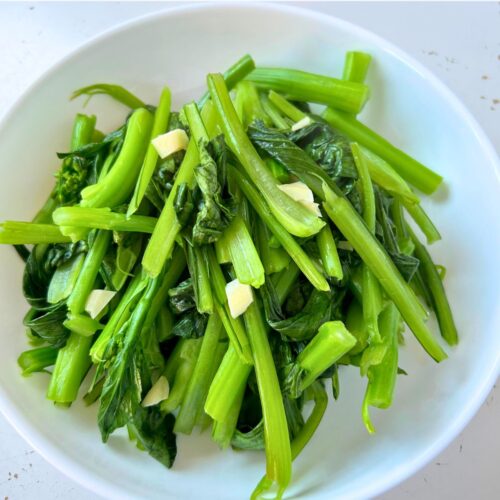
Yu Choy with Garlic, Easy Chinese Vegetable Stir-Fry
Ingredients
- 1 pound yu choy*
- 2 cloves garlic minced
- 2 teaspoons olive oil
- 1/8 teaspoon salt 1-2 shakes
- 2 tablespoons water
Instructions
- Wash the yu choy in a large bowl with cold water until the rinse water is clean and grit-free. Separate the large leaves from the stalk and trim the stalk and stems into bite sized pieces (3 inches long). Sort the pieces into two bowls, one for leaves and tender tips only and a second bowl for stems and stalks. Set aside until ready to cook.
- Preheat a large frying pan or stock pot on medium heat until a drop of water sizzles (4-5 minutes). Add the oil and swirl to coat. Add a sprinkle of salt and the minced garlic, and saute until fragrant (30-60 seconds). Watch carefully and do not allow the garlic to blacken.
- Add the yu choy stems and stalks, saute until they're 50% bright green (1-2 minutes). Add the leaves and stir fry until they're partially wilted (1-2 minutes). Depending on how wet were your veggies when you added them to the frying pan, add 1-2 tablespoons of water to the pan to flash steam the vegetables until cooked through (1-2 minutes). Serve immediately.
- Optional, season with a light sprinkle of salt or a small amount (1/2 to 1 teaspoon) of soy sauce, sesame oil, or oyster sauce.
Notes
Nutrition
Related Recipes:
I like to serve this simply prepared Chinese vegetable stir fry as part of our meals. It is a refreshing contrast when I’m serving something rich or salty such as Steamed Spare Ribs with Black Bean Sauce or Lu Rao Fan, Braised Pork and Egg Rice Bowl.
Top bowls of porridge or soupy noodles with stir-fried veggies. I add them to Wonton Mein (Wonton Noodle Soup), Pho Ga Recipe, Easy Vietnamese Chicken Pho Soup, and Instant Pot Chicken Congee (Chicken Jook).
If you want to try other Asian vegetables, I have a stir fried version of Baby Bok Choy with Garlic and Ginger Recipe in addition to the Instant Pot version of the recipe mentioned earlier. I also love Fuzzy Melon (Moa Gua) with Vermicelli, I could eat it by itself as a meal, yum! Another one of my favorite vegetables is napa cabbage, which is sweet and tender, Napa Cabbage Stir Fry: Easy, Kid Approved, and a Super Food.
Thanks for reading, please help Nut Free Wok!
If you like this post or recipe, please be sure to give a 5 star rating, leave a comment, and share this post! Your support means a lot to me.
Subscribe to Nut Free Wok’s email subscription (be sure to respond to the confirmation email). You will be notified by email next time I publish another post or recipe and I won’t send you spam or share your email address with anyone.
Disclosure/Disclaimer:
I may mention the names of stores and/or brand names of products that I use because readers ask and I share products and sources which I use and think may be helpful to readers, all opinions are my own. Please note that manufacturing practices and ingredients can change at anytime without notice and readers are always responsible for assuring allergen safety before buying or consuming foods. NutFreeWok.com is a participant in the Amazon Services LLC Associates Program, an affiliate advertising program designed to provide a means for sites to earn advertising fees by advertising and linking to Amazon.com. Thank you for reading!

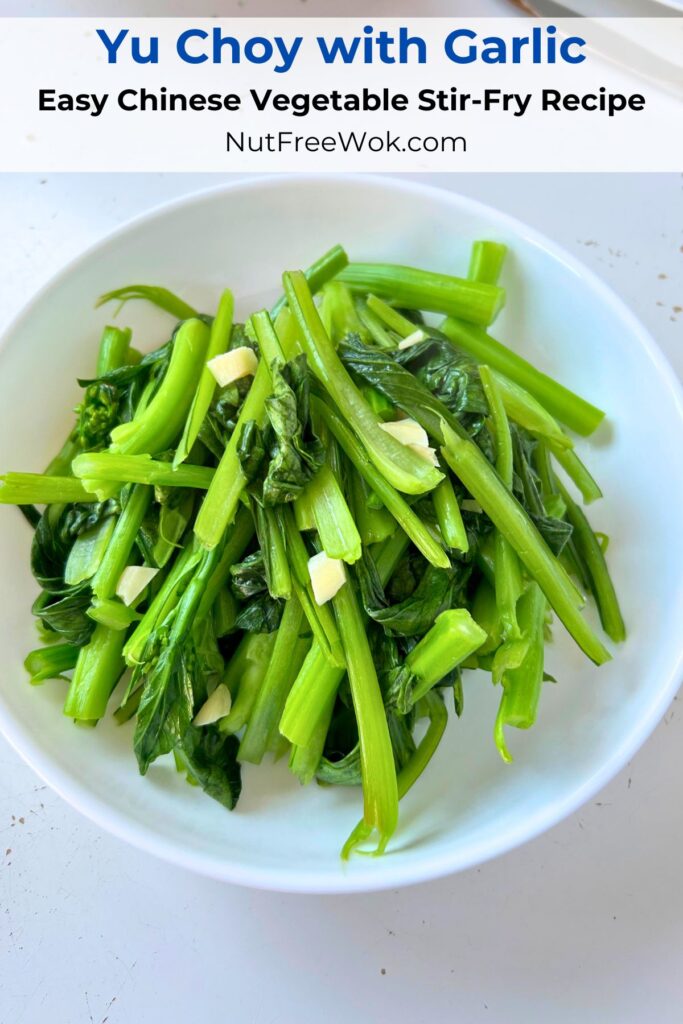
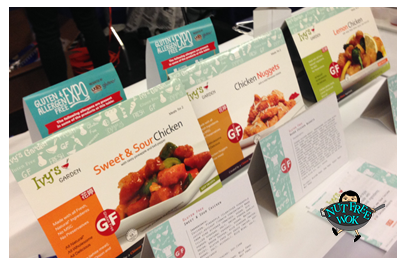
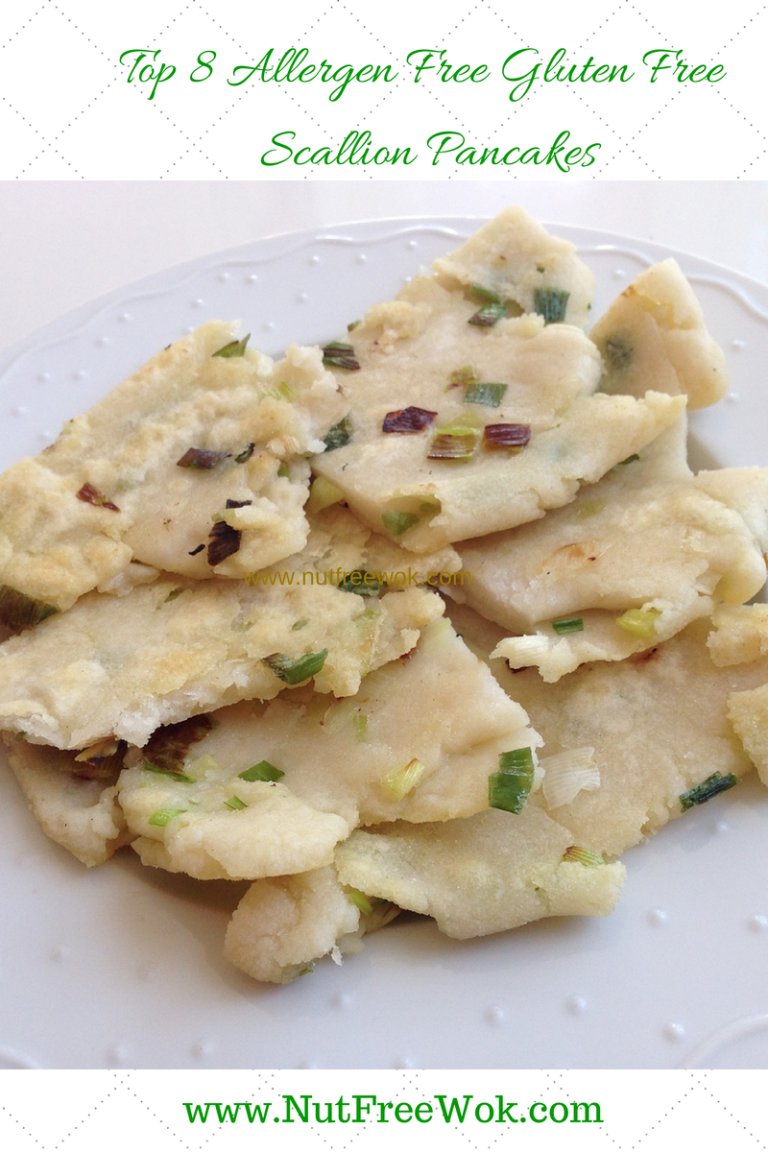
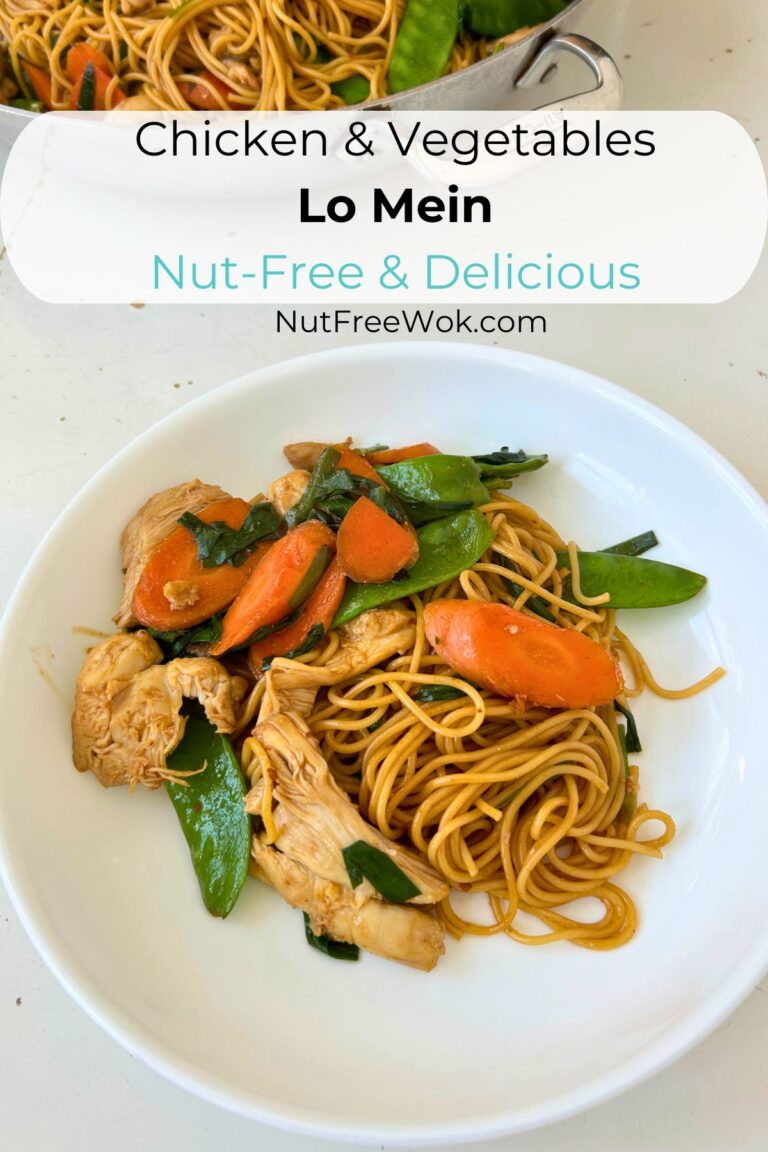

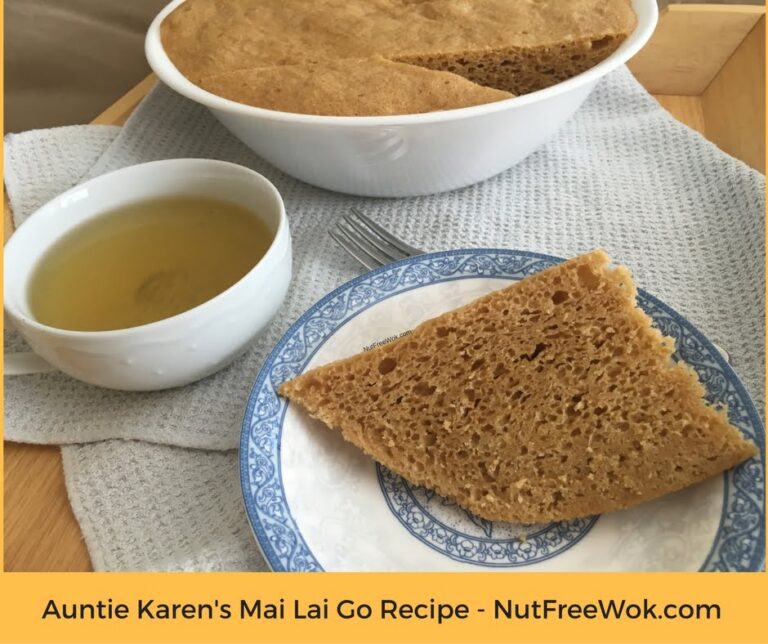
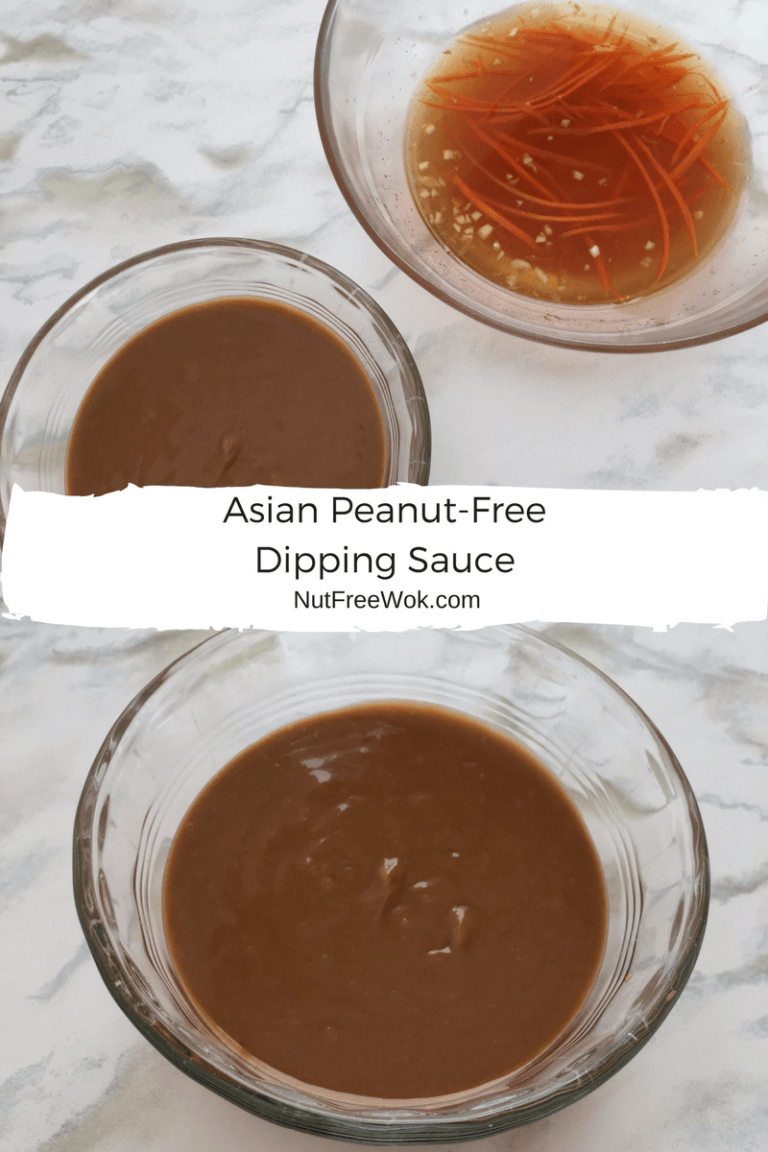
I believe I had these when visiting Hong Kong. I’m hoping to in my garden in late summer. Just ordered some seeds! 🙂
Oh how fun, can’t wait to hear how they grow in a home garden.
So tasty and bright!
Thanks, it’s a great vegetable to serve with dishes that are rich or heavily seasoned.
This is a regular staple at our house! Try it and let me know what you think below.